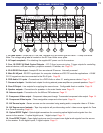
waves is a desirable effect to a point. Different locations in the room will have waves that collide with one
another. This collision can cause a superposition (addition or subtraction) of the audible wavelength. In
either case, these locations are referred to as nodes. If a positive node occurs in the primary listening
position, that frequency drowns out all other frequencies at that location, resulting in limited frequency
response for that location in the room. A node can occur at any frequency, however nodes are much more
prevalent in the lower frequency ranges (below 130Hz). In these lower frequencies, the wavelengths are
physically long enough that a superposition can have a more dramatic effect than frequencies at a higher
(shorter) wavelength. A notch filter provides a means by which the receiver can effectively ‘notch’ out
resonant frequencies to achieve a balanced frequency response for a given room. Once the frequency
response has been returned to its reference level, a fuller, more dynamic audio reproduction can be heard.
B& K supports three separate notch filters for the frequency range of 20 Hz to 300Hz.
DVD-Audio (also referred to as MLP) - DVD-Audio (also referred to as MLP
TM
) - Meridian
R
Lossless
Packing. MLP
TM
is a lossless compression system for high-quality linear PCM audio. For DVD-Audio MLP
TM
performs lossless compression of 1 to 6 channels of 14 to 24-bit material sampled at rates between 32kHz
and 192kHz. With lossless compression, the decompressed signal is bit-for-bit identical to the master, just
'packed' into a lower data rate which ultimately results in a reduced size to be stored on the disc. Currently,
DVD-Audio can only be delivered to your receiver via the analog 5.1 inputs. Sound will normally come from
your front left, front right, center, left surround, and right surround speakers, as well as your subwoofer, but
your processor can produce sound in one (mono) to seven channels. Dolby Pro Logic IIx is used to matrix
the surround back left and surround back right channels if a seven channel configuration is used.
SACD (Super Audio CD) - Is a new audio recording format aimed at providing higher fidelity audio reproduc-
tion than the compact disc. It was developed by Sony and Philips. The sound of SACD comes directly
from Direct Stream Digital (DSD) recording technology. SACD disks generally contain a 2-channel stereo mix.
Many also contain a 5.1 surround sound mix. DSD's simplified mechanism for recording and playback results
in a frequency response over 100kHz and a dynamic range over 120dB across the audible frequency range.
DSD increases the resolution of music by more closely following the original wave form of the music, which
results in music reproduction that is remarkably pure and faithful to the original. For additional information
concerning the technology behind SACD, visit Sony Electronics SACD.
Cinema Processing - Cinema is an exclusive set of standards and technologies that can be applied to any
B& K surround mode. In a typical movie theater the front left, right, and center speakers are located behind
the screen. The screen tends to block high frequency information. Therefore, movie soundtracks often have
boosted high frequency content to compensate for the effects of the screen. This boost can cause some
soundtracks to sound overly bright in a home theater where speakers are typically not behind a screen. B& K
cinema mode adjusts the front left, right, and center frequency response to compensate for the boost applied
for the movie theater.
High Current Amplifiers - A high-current amplifier is capable of delivering power into low impedance
speakers without going into protection and/or shutting down. Ideally, an amplifier's output power would double
every time the load presented at its output is halved. In a typical amplifier-speaker circuit, voltage and current
are delivered to a very complex load consisting of speaker drivers, resistors, inductors, and capacitors.
Voltage may be thought of as the potential to do work, and current as what actually flows to do the work.
Although basic power may be calculated by the simple multiplication of voltage and current, it is the delivery
of the power from the amplifier to the complex speaker load that accounts for why two amplifiers may have
the same power rating into identical impedances (speaker loads), but deliver a significantly different sound
quality. Some of these sound quality differences may include perceived loudness, depth, and clarity. High
quality speakers can have nominal impedances from 8 - 2 Ohms. During very loud and dynamic audio
passages, the speaker load may dip below 2 Ohms. These low impedance drops may cause a high voltage
power amplifier with limited power storage capacity to sound harsh and distorted. A high-current amplifier
operates with much less effort and typically does not have any problem with low impedance speakers. B&K
amplifiers and receivers are High Current Power amplifiers.
AUDIO / VIDEO OVERVIEW
9


















